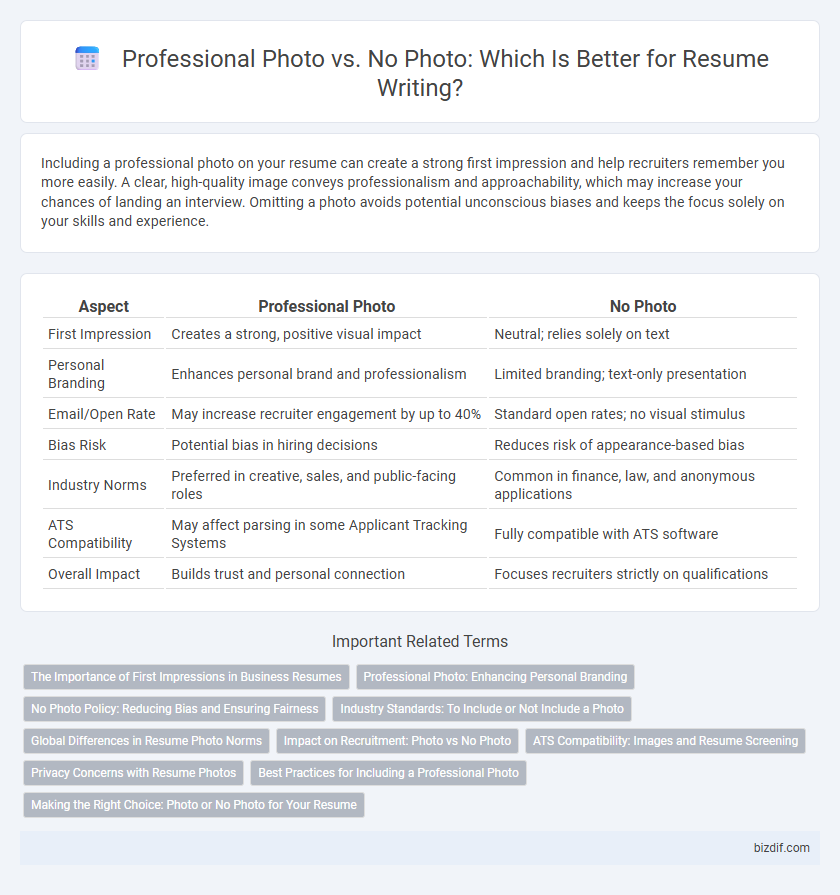Including a professional photo on your resume can create a strong first impression and help recruiters remember you more easily. A clear, high-quality image conveys professionalism and approachability, which may increase your chances of landing an interview. Omitting a photo avoids potential unconscious biases and keeps the focus solely on your skills and experience.
Table of Comparison
| Aspect | Professional Photo | No Photo |
|---|---|---|
| First Impression | Creates a strong, positive visual impact | Neutral; relies solely on text |
| Personal Branding | Enhances personal brand and professionalism | Limited branding; text-only presentation |
| Email/Open Rate | May increase recruiter engagement by up to 40% | Standard open rates; no visual stimulus |
| Bias Risk | Potential bias in hiring decisions | Reduces risk of appearance-based bias |
| Industry Norms | Preferred in creative, sales, and public-facing roles | Common in finance, law, and anonymous applications |
| ATS Compatibility | May affect parsing in some Applicant Tracking Systems | Fully compatible with ATS software |
| Overall Impact | Builds trust and personal connection | Focuses recruiters strictly on qualifications |
The Importance of First Impressions in Business Resumes
A professional photo on a resume can create a positive first impression by conveying confidence, approachability, and professionalism, which are critical in competitive job markets. Resumes with high-quality photos often stand out to recruiters, enhancing personal branding and making candidates more memorable. However, the inclusion of a photo should align with industry norms and company culture, as some regions or sectors prefer anonymity to prevent bias.
Professional Photo: Enhancing Personal Branding
Including a professional photo on a resume significantly enhances personal branding by creating a positive first impression and fostering a sense of trust with potential employers. A high-quality, well-composed image communicates professionalism, confidence, and attention to detail, differentiating candidates in competitive job markets. Visual representation aligns with modern recruitment trends that value personal connection and authenticity, ultimately increasing the likelihood of interview opportunities.
No Photo Policy: Reducing Bias and Ensuring Fairness
Adopting a no photo policy in resume writing helps reduce unconscious bias by focusing solely on a candidate's skills, experience, and qualifications. Research shows that excluding photos promotes fairness in hiring decisions and increases diversity by preventing discrimination based on appearance, age, gender, or ethnicity. Companies implementing no photo policies report more objective evaluations and improved equity in candidate selection.
Industry Standards: To Include or Not Include a Photo
Including a professional photo on a resume is common in industries such as modeling, acting, and customer-facing roles where personal appearance is a key factor. In contrast, sectors like technology, finance, and law often discourage photos to prevent unconscious bias and comply with Equal Employment Opportunity guidelines. Understanding industry-specific standards ensures that your resume aligns with recruiter expectations and enhances your chances of securing an interview.
Global Differences in Resume Photo Norms
Professional photo norms on resumes vary significantly across regions; in Europe and Asia, including a high-quality photo is often standard practice to create a strong first impression, whereas in the United States, Canada, and the United Kingdom, photos are generally discouraged to prevent unconscious bias and comply with anti-discrimination laws. Data from Human Resources surveys indicate that 85% of European employers prefer resumes with photos, while over 70% of North American recruiters avoid them to maintain fair hiring practices. Understanding these regional differences ensures that job applicants tailor their resumes appropriately to optimize acceptance and align with cultural expectations.
Impact on Recruitment: Photo vs No Photo
Including a professional photo on a resume can enhance recruiter engagement by creating a positive first impression and adding a personal touch, potentially increasing interview callbacks. Conversely, resumes without photos help minimize unconscious bias, promoting a focus on skills and qualifications rather than appearance. The decision to include a photo should align with industry standards and regional hiring practices, as its impact on recruitment varies by context.
ATS Compatibility: Images and Resume Screening
Including a professional photo on a resume can hinder ATS compatibility as many applicant tracking systems are designed to scan text-based content and may misinterpret or exclude image data during screening. Resumes without photos ensure that essential keywords and qualifications are accurately parsed, increasing the chances of passing automated filters. Emphasizing clear, text-focused formatting optimizes resume visibility within ATS algorithms and improves recruiter accessibility.
Privacy Concerns with Resume Photos
Including a professional photo on a resume can raise significant privacy concerns, as personal images may be misused or lead to unconscious bias during the hiring process. Many candidates prefer to omit photos to protect their identity and maintain focus on skills and experience rather than appearance. Employers increasingly respect privacy by prioritizing resume content over photos to ensure fair and unbiased candidate evaluation.
Best Practices for Including a Professional Photo
Including a professional photo on a resume can enhance personal branding and create a positive first impression for recruiters, especially in industries like marketing, sales, and media where appearance plays a key role. Best practices for resume photos include using a high-quality headshot with a neutral background, dressing professionally, and ensuring good lighting and a friendly, approachable expression. Avoid casual or unprofessional images, and confirm that including a photo aligns with regional norms and company policies to prevent potential biases during hiring.
Making the Right Choice: Photo or No Photo for Your Resume
Including a professional photo on your resume can enhance personal branding and create a positive first impression, especially in industries like sales or media where visual identity matters. However, omitting a photo is often recommended to prevent unconscious bias and maintain focus on qualifications, particularly in regions with strict anti-discrimination hiring practices. Carefully evaluate industry standards, regional preferences, and company culture to make the right choice between a professional photo or no photo for your resume.
Professional Photo vs No Photo Infographic

 bizdif.com
bizdif.com